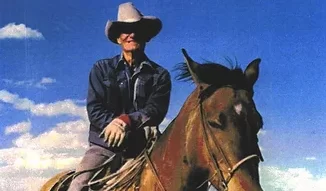ALL IN A DAYS WORK
This is the sentence that Bud Huseman used at the end of a telling of an adventure or misadventure. Albert William Huseman was his given name, but little Buddy soon was shortened to Bud. Born in Ogden Utah in 1908 to the parents of german/dutch immigrants.
His Father was a butcher and when pasturage got tight, he sold his business and bought a ranch in Lonetree Wyoming, 120 miles from Ogden. Bud and an older sister and brother were sent ahead of the rest of the family with a wagon load of supplies. The trip took three (3) days.
As they arrived in Lonetree, some of the local boys were breaking horses and seeing the new arrivals led the Huseman party to their new ranch. Clyde Decker was tending the new place until the Huseman’s arrived. Clyde was a horseback and opened the gate to let the wagon in. Then he proceeded to close the gate without dismounting. It made a great impression on little Bud and he vowed then and there to be a cowboy. Bud completed his formal education by graduating from 8th grade from the Lonetree school. Fairly normal for a young man in that day. He went to work for his father on the ranch. He worked livestock, fenced, dug ditches, irrigated, broke work and saddle horses and put up wild hay. He cut corral poles, firewood and fixed equipment. He learned to do, make do or do without.
In the spring of his 17th year, he got the “itch” to go his own way. With his older brother Ernie, they lit out for “up north”. Their transportation was Ernie’s model T Ford. With flour sacks for luggage they threw their saddles in and headed for Big Piney. They got cowboy work in Big Piney, Pinedale and Jackson Hole. Those were the Golden Days of Rodeo. Most all the contestants were full time working cowboys who took a little time on weekends to ride, rope and bulldog in the small town rodeos. Most of them competed in three or four events. Bud himself rode broncs, roped calves and bulldogged steers. At one of those rodeos there was a steer in the wild cow milking herd and Buds team caught it by mistake. Bud reached the cup under the steer, pulled the cup out, spit in the cup and ran to the judge pouring out the “Milk” as he arrived. Apparently the ruse worked as Bud’s team won. Bud said that the entry fees were usually about $2.50 per event. Four event entry fees would amount to a half months’ wages back then.
Coming back to Bridger Valley, Bud did several “outside jobs”. He worked as a “River Pig” keeping the ties floating down Blacks Fork from the Utah line camp all the way to Granger. He had two sets of clothes as he got soaked every day. He hung the wet ones up at night and wore the dry ones the next day. He also tended the mash fires for a prominent local bootlegger. After the tie hack job and the whiskey making jobs he headed back to Jackson Hole. He went to work for Pete Hanson and worked with Pete’s son Cliff who later became Governor of the state. After the haying season Bud went to Dubois breaking horses. Brother Ernie got hurt badly on a bronc and Bud worked to pay the bills. That was the last bronc Ernie ever rode.
Winters being what they were in southwest Wyoming the brothers struck out for winter work in sunny Arizona. They had a flat tire between Seligman and Kingman. A rancher passing by noting the saddles in their car offered them cowboy work. Bud said the grub was a little rough with chili peppers and beans being the daily chuck. The next job had a cook that used dutch ovens to make peach cobbler and other range delicacies. Bud said the food was better than home. He learned to work cattle in the open without fences. Mesquite and brush and ringy cattle taught many lessons. He slept out doors with the herd and starry skies for his blanket.
Bud went onto Benson California “riding line”. They brought him groceries once a week. One Christmas time he held back canned peaches and canned salmon for his Christmas dinner. From there he worked thru California then up through Nevada. After some five years he got a letter from his father asking him to come home and help on the family ranch. Bud did go home and met and married the local school marm, Lyda Curtis. The couple had to keep the marriage secret because Wyoming law prohibited married women from teaching in public schools. They were perfectly mated and each had found the love of their lives. Together they built a good ranch on the Henry’s Fork River. Two girls were born to the couple, Lois Gay and Nancy Ann. Bud and Lyda got them clear thru college and they followed their mother in becoming teachers themselves.
Bud was a good hand in the branding corral. In Lonetree the calves were all roped to be castrated, ear marked and vaccinated. Unless you were over seventy you mugged and the seniors were the ropers. He roped competitively in the Old Timers Rodeo in Lander as well.
When the branding fire was dying and all the irons were out; Bud would be setting next to the blue coleman cooler that contained the “branding supplies”, a solo cup in hand with Canadian Lord Calvert diluted with a little 7- up. He would tell of one of his many tales and we never heard the same one twice. This lanky old cowboy who vowed to be a cowboy as a 7-year-old would always conclude with: “It was all in a day’s work”.


